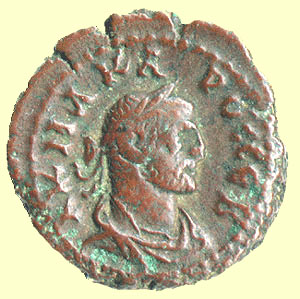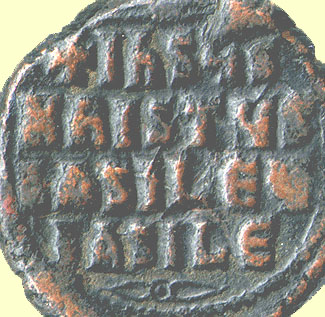 Contents -
Previous Article -
Next Article
Contents -
Previous Article -
Next Article
Many Languages and Cultures Within One Great Empire
By A. D. 117. the Roman Empire was a vast swath of territory covering most of Europe and much of Western Asia from Britain in the West to Persia in the East. It stretched from the German forests of Northern Europe to the burning sands of the Sahara Desert and the inhospitable reaches of the Upper Nile in Egypt. This empire encompassed a great diversity of languages, cultures, and religions. It would be too much to expect that all the peoples living under the umbrella of such a cosmopolitan empire would know or learn how to read Latin. Latin was just an obscure Central Italian language before the Romans conquered much of the known world. With its conquering legions, the Romans brought their language with them and it became the offficial language of the empire. All government records were kept in Latin and legal transactions were carried out in Latin. In fact, if you were an educated person in the Roman Empire you were more likely to speak Greek than Latin. The whole Eastern half of the empire spoke Greek almost exclusively. Up until A. D. 300, coins struck in the East bore legends in Greek or a curious combination of Greek and Latin letters. Many people in the Roman Empire could not read at all. It is this diversity of cultures in the empire itself coupled with the fact that often only the well-to-do could read that made coins such an ideal medium of communication.
 After the decline of the West, the Eastern Roman Empire remained powerful and even grew in importance. Since the native language of most of the Middle East had been Greek ever since the times of the Ptolemaic and Seleukid rulers, the Byzantine Empire's government business came more and more to be conducted in Greek. This gradual process of reverting to the use of Greek had an unusual impact on the written language that has created some interesting puzzles for coin collectors. Many of the Latin letters were found to be so useful that they were incorporated into this evolving form of Byzantine Greek. The reverse inscription on the coin at right reads "IhSUS XhiStUS BASILEu BASILE" which translates "Jesus Christ King of Kings". The original Greek alphabet used a lambda where we would use an "L" and a rho where we would use an "R". Notice the presence of the "L", of definite Latin origin, in this inscription. The coin is a Byzantine type from about A. D. 1100 - 1200. The obverse has an image of Christ instead of the emperor.
After the decline of the West, the Eastern Roman Empire remained powerful and even grew in importance. Since the native language of most of the Middle East had been Greek ever since the times of the Ptolemaic and Seleukid rulers, the Byzantine Empire's government business came more and more to be conducted in Greek. This gradual process of reverting to the use of Greek had an unusual impact on the written language that has created some interesting puzzles for coin collectors. Many of the Latin letters were found to be so useful that they were incorporated into this evolving form of Byzantine Greek. The reverse inscription on the coin at right reads "IhSUS XhiStUS BASILEu BASILE" which translates "Jesus Christ King of Kings". The original Greek alphabet used a lambda where we would use an "L" and a rho where we would use an "R". Notice the presence of the "L", of definite Latin origin, in this inscription. The coin is a Byzantine type from about A. D. 1100 - 1200. The obverse has an image of Christ instead of the emperor.
Go to next article: Using Compact Symbols to Broadcast News and Ideas
Go to previous article: Imperial Propaganda on Reverses of Roman Coins
Return to Roman Coins Table of Contents
 After the decline of the West, the Eastern Roman Empire remained powerful and even grew in importance. Since the native language of most of the Middle East had been Greek ever since the times of the Ptolemaic and Seleukid rulers, the Byzantine Empire's government business came more and more to be conducted in Greek. This gradual process of reverting to the use of Greek had an unusual impact on the written language that has created some interesting puzzles for coin collectors. Many of the Latin letters were found to be so useful that they were incorporated into this evolving form of Byzantine Greek. The reverse inscription on the coin at right reads "IhSUS XhiStUS BASILEu BASILE" which translates "Jesus Christ King of Kings". The original Greek alphabet used a lambda where we would use an "L" and a rho where we would use an "R". Notice the presence of the "L", of definite Latin origin, in this inscription. The coin is a Byzantine type from about A. D. 1100 - 1200. The obverse has an image of Christ instead of the emperor.
After the decline of the West, the Eastern Roman Empire remained powerful and even grew in importance. Since the native language of most of the Middle East had been Greek ever since the times of the Ptolemaic and Seleukid rulers, the Byzantine Empire's government business came more and more to be conducted in Greek. This gradual process of reverting to the use of Greek had an unusual impact on the written language that has created some interesting puzzles for coin collectors. Many of the Latin letters were found to be so useful that they were incorporated into this evolving form of Byzantine Greek. The reverse inscription on the coin at right reads "IhSUS XhiStUS BASILEu BASILE" which translates "Jesus Christ King of Kings". The original Greek alphabet used a lambda where we would use an "L" and a rho where we would use an "R". Notice the presence of the "L", of definite Latin origin, in this inscription. The coin is a Byzantine type from about A. D. 1100 - 1200. The obverse has an image of Christ instead of the emperor.
 Contents -
Previous Article -
Next Article
Contents -
Previous Article -
Next Article